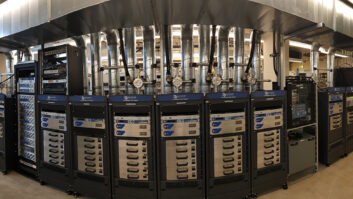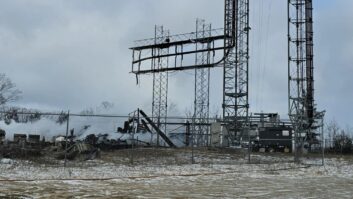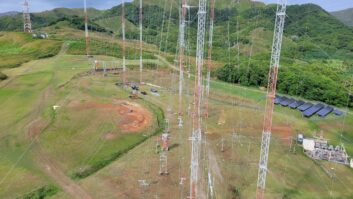Multitenant towers
Oct 1, 2002 12:00 PM, By John Battison, P.E., technical editor, RF
As wide-open areas suitable for tower erection decrease inavailability, vertical real estate is becoming increasingly attractiveto potential broadcasters. The use of somebody else’s tower can beattractive, but before rushing into a contract with an existing towerowner, consider all the problems that can occur as well as the FCCrequirements and rules.
Urban growth and an increased need forvertical space have made tower space more valuable. In addition, mostcommunities frown on building new towers despite the increasedneed.

Adequate and comprehensive insurance is essential. There must be noquestion as to liability of the landlord or of the tenant in the eventof catastrophe attributable to technical operation.
From an existing tower owner’s point of view, renting space mayoffer an opportunity for tax write-offs by donating tower space toreligious broadcasters and other charitable institutions. When properlyhandled, it might turn the engineering department into a profit center.This would earn the respect and appreciation of the general manager whowould be pleasantly surprised to see money flowing into the engineeringdepartment instead of out.
On the other hand, a new station might find leasing space on anexisting tower to be preferable to a large capital expenditure. Leaserenewal options are important and long-term leases are essential forstability. If you had difficulty finding a suitable site in the firstplace, it is not likely that any more suitable sites will becomeavailable as time passes. On the contrary, normal industrial and urbangrowth will continue to consume open areas, and FAA and zoningrestrictions are likely to become more difficult as time passes. Thesefactors can only increase the value of a tower.
A 20-year lease with renewal options would be ideal, but is notalways possible. There is nothing worse for a licensee than to have hisantenna site taken from him. I recall the case of a station with a fourtower, widely-spaced rectangular array on land that used to be adesert. The land suddenly became valuable as a potential mall. Theoriginal lease had an option to renew but there was no priceprotection. As a result the station went dark and the mall wasbuilt.
What can happen if an existing AM operator is preparing to rentspace on his tower to an FM broadcaster? This situation is fraught withcomplications if the AM general manager and his chief engineer do notsit down and prepare a list of technical problems that must be solvedand completely covered in the contract. The general manager and thestation’s attorney must also draft a satisfactory and comprehensivelease. At this point, the chief engineer should be involved in all thetechnical requirements. If this procedure is followed there should beno difficulty in consummating a satisfactory tenancy.
Responsibilities
Responsibility for tower lighting is often the cause of FCCviolations. Proper understanding of the new tower registrationrequirements and the divisions of responsibility for lighting in theCommission’s new rules should eliminate confusion.
A large amount of money will be spent adapting the AM tower to carrythe FM radiator. Isolating the tower and feeding the new FM antenna canbe accomplished by using an isolating coil or converting to a groundedfolded unipole radiator. The former method is less costly, but thelatter provides the possibility of added revenue without furtherexpense, if the tower can support additional radiators.
While AM towers can be used foradditional tenants, additional costs will be incurred.

Provided that the tower can support the additional antenna and theweight and wind loading of a folded unipole, the grounded tower isoptimal because lightning problems should be greatly reduced, signalimprovement may be noticed and the potential exists for additionaltenants without the need for any additional antenna changes.
Another important point that can be overlooked is �downtime.� The FCC requires that non-ionizing radiation be reduced oreliminated during work on antennas and towers. This means completelyshutting down all transmitters or operating with reduced power.
The AM transmitter will have to be powered down while the AM towerchanges are being made. Who will pay for this lost time? Converting toa folded unipole will take longer and require even more down time.Installing the FM antenna and transmission line can be performed whileadding the folded unipole.
If another AM station is to be added to the existing operation (i.e.diplexing), problems of down time should be fewer. No antenna changeswill be required, and new transmitter and coupling equipmentconstruction can continue without interruptions to the existing AMoperation until the time comes for the eventual connection and tuning.Such diplexing will result in additional cost to the landlord in theprovision of filters and system retuning. In addition, the cost of thelandlord’s lost air time will have to be covered in the leasingagreement.
Adding an FM antenna to an existing FM tower involves a tower studyto make sure it’s safe. If using a wideband common antenna andtransmission line, be sure to spell out the individual responsibilitiesand performance requirements in the event of RF problems. Such aproposed installation requires thorough engineering examination priorto drawing up contracts.
It seems that the trend is toward multiple tenants on towers.Certainly in cases of antenna farms and specific tall buildings,multiple tenants have a long history of successful operation. Forsmaller stations in individual markets, multiple tenancy is becoming aviable solution to the lack of open space, FAA restrictions andshortsighted state, county and local zoning boards that bow only to thepublic utility denominator.
E-mail Battison at[email protected].












